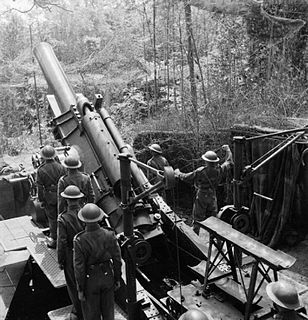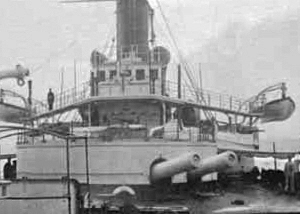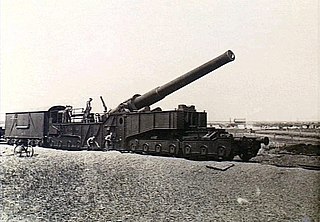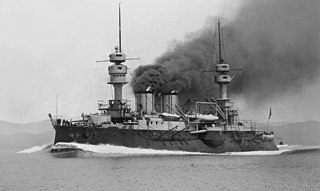 W
WThe 12-inch coast defense mortar was a weapon of 12-inch (305 mm) caliber emplaced during the 1890s and early 20th century to defend US harbors from seaborne attack. In 1886, when the Endicott Board set forth its initial plan for upgrading the coast defenses of the United States, it relied primarily on mortars, not guns, to defend American harbors. Over the years, provision was made for fortifications that would mount some 476 of these weapons, although not all of these tubes were installed. Ninety-one of these weapons were remounted as railway artillery in 1918-1919, but this was too late to see action in World War I. The railway mortars were only deployed in small quantities, and none overseas. The fixed mortars in the Philippines saw action in the Japanese invasion in World War II. All of the fixed mortars in the United States were scrapped by 1944, as new weapons replaced them, and the railway mortars were scrapped after the war. Today, the only remaining mortars of this type in the 50 states are four at Battery Laidley, part of Fort Desoto near St. Petersburg, Florida, but the remains of coast defense mortar emplacements can be seen at many former Coast Artillery forts across the United States and its former territories. Additional 12-inch mortars and other large-caliber weapons remain in the Philippines.
 W
WThe 12-inch coastal defense gun M1895 (305 mm) and its variants the M1888 and M1900 were large coastal artillery pieces installed to defend major American seaports between 1895 and 1945. For most of their history they were operated by the United States Army Coast Artillery Corps. Most were installed on disappearing carriages, with early installations on low-angle barbette mountings. From 1919, 19 long-range two-gun batteries were built using the M1895 on an M1917 long-range barbette carriage. Almost all of the weapons not in the Philippines were scrapped during and after World War II.
 W
WType 1915 305 mm howitzer was a Russian heavy howitzer that saw service during World War I and II. Originally intended for Naval use, it was later purchased by the Army at a cost of 271,500 Rubles apiece, with the first order of 8 being sent on 13 August 1915.
 W
WThe 305 mm howitzer M1939 (Br-18) was a Soviet superheavy siege howitzer used by the Soviet Union during World War II. After the Germans occupied Czechoslovakia in March 1939 they took over the Škoda Works, which had been working on this design and a companion 210 mm gun. After a successful test firing 5 July 1939, as a result of the Molotov–Ribbentrop Pact the Germans sold both designs to the Soviet Union. It is not entirely clear that Skoda actually built the weapons itself or merely supplied the blueprints. At any rate, very few weapons seem to have been built; so few, in fact, that there's no record of the Germans capturing any during Operation Barbarossa.
 W
WThe Armstrong Whitworth 12-inch naval gun of 40 calibres length was designed by and manufactured mainly by Armstrong's ordnance branch, Elswick Ordnance Company. It was intended for the Royal Navy's Royal Sovereign-class battleships, but budgetary constraints delayed their introduction. The first units were instead supplied to Japan. As the Type 41 12-inch (305 mm) 40-calibre naval gun it was the standard main battery on several early United Kingdom-built pre-dreadnought battleships of the Imperial Japanese Navy.
 W
WThe Ordnance BL 12-inch howitzer was a scaled-up version of the successful BL 9.2-inch siege howitzer.
 W
WThe BL 12 inch naval gun Mk I was a British rifled breech-loading naval gun of the early 1880s intended for the largest warships such as battleships and also coastal defence. It was Britain's first attempt to match the large guns being installed in rival European navies, particularly France, after Britain transitioned from rifled muzzle-loading guns to the modern rifled breech-loaders somewhat later than the European powers. Mks I - VII all had a barrel of approximately 303 inches in length and similar performance.
 W
WThe Armstrong Whitworth 12-inch naval gun of 40 calibres length was designed by and manufactured mainly by Armstrong's ordnance branch, Elswick Ordnance Company. It was intended for the Royal Navy's Royal Sovereign-class battleships, but budgetary constraints delayed their introduction. The first units were instead supplied to Japan. As the Type 41 12-inch (305 mm) 40-calibre naval gun it was the standard main battery on several early United Kingdom-built pre-dreadnought battleships of the Imperial Japanese Navy.
 W
WThe British Ordnance BL 12 inch gun Mk IX on truck, railway mounted surplus 12 inch Mk IX W naval guns, manufactured by Woolwich Arsenal in 1906, on various railway platforms to provide mobile long-range heavy artillery for the British Army on the Western Front in World War I.
 W
WThe British Ordnance BL 12 inch howitzer on truck, railway, a type of railway gun, was developed following the success of the 9.2-inch siege howitzer. It was similar but unrelated to the 12-inch siege howitzers Mk II and IV.
 W
WThe BL 12-inch Mark VIII naval gun was one of the first large British rifled breech-loading naval guns designed for the higher pressures generated by the new cordite propellant of the 1890s, and Britain's first large wire-wound gun. It represented a major advance compared to previous British guns.
 W
WThe BL 12 inch Gun Mark X was a British 45-calibre naval gun which was mounted as primary armament on battleships and battlecruisers from 1906. It first appeared on HMS Britannia.
 W
WThe BL 12-inch Mark XI and Mark XII gun were British breech loading (BL) naval guns of 50-calibres length mounted as primary armament on dreadnought battleships from 1910.
 W
WThe Canon de 305 mm Modèle 1887 was a heavy naval gun used as the main armament of a number of French pre-dreadnoughts and coastal defense ships during World War I. Eight were converted to railway artillery in World War I and four were used during World War II.
 W
WThe EOC 12 inch 45 calibre gun were various similar 12-inch wire-wound naval guns designed and manufactured by Elswick Ordnance Company to equip ships that the parent company Armstrong Whitworth built and/or armed for several countries before World War I.
 W
WLimbo, or Anti Submarine Mortar Mark 10, was the final development of the forward-throwing anti-submarine weapon Squid, designed during the Second World War and was developed by the Admiralty Underwater Weapons Establishment in the 1950s.
 W
WOrdóñez guns are a type of coastal artillery that Salvador Diaz Ordóñez, an artillery officer in the Spanish Army, designed in the late 19th century. Most of the models were field guns, but some were howitzers. The guns ranged in caliber from 150mm (5.9") to 305mm (12"). They were made in Spain, at the Trubia Arms Factory, in Asturias, and the Spanish installed them in forts and batteries at home, for instance at Ceuta, and throughout their empire, in Puerto Rico, Cuba, and the Philippines. The Ordóñez guns appear to have been used for protecting Spain's colonies; reportedly the Spanish generally reserved the higher quality, and much more expensive, Hontoria guns for the defense of Spain.
 W
WThe RML 12-inch 25-ton guns were large rifled muzzle-loading guns of mid-late 1800s used as primary armament on British ironclad turret battleships and coastal monitors, and also ashore for coast defence. They were the shorter and less powerful of the two 12-inch (305-mm) British RML guns, the other being the 35-ton gun.
 W
WRML 12-inch 35-ton guns were large rifled muzzle-loading guns used as primary armament on British battleships of the 1870s. They were the longer and more powerful of the two 12-inch British RML guns, the other being the 25-ton gun.
 W
WThe 12-inch 40-caliber naval gun was the standard main weapon of the pre-dreadnought battleships of the Imperial Russian Navy. Sixty-eight guns of the first production run were built in 1895–1906 by the Obukhov Works in Saint Petersburg. They were installed on seventeen battleships starting with Sissoi Veliky and Tri Sviatitelia and ending with the Andrei Pervozvanny class. A second production run was ordered to Russian and British gunmakers during World War I.
 W
WThe Škoda 30.5 cm Mörser M.11 was a siege howitzer produced by Škoda Works and used by the Austro-Hungarian Army during World War I and by Nazi Germany in World War II.
 W
WSquid was a British World War II ship-mounted anti-submarine weapon. It consisted of a three-barrelled mortar which launched depth charges. It replaced the Hedgehog system, and was in turn replaced by the Limbo system.
 W
WThe Type 7 30 cm howitzer was a howitzer used by the Imperial Japanese Army in the Second Sino-Japanese War, Soviet–Japanese border conflicts and during the Pacific Campaign in World War II. The designation Type 7 indicates its year of introduction, the seventh year of the reign of Emperor Taishō, or 1918 according to the Gregorian calendar.
 W
WThe EOC 12 inch 45 calibre gun were various similar 12-inch wire-wound naval guns designed and manufactured by Elswick Ordnance Company to equip ships that the parent company Armstrong Whitworth built and/or armed for several countries before World War I.